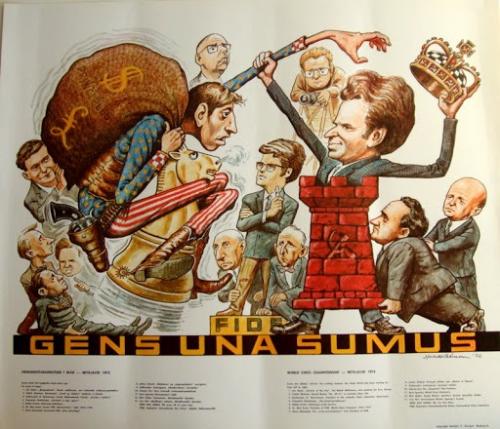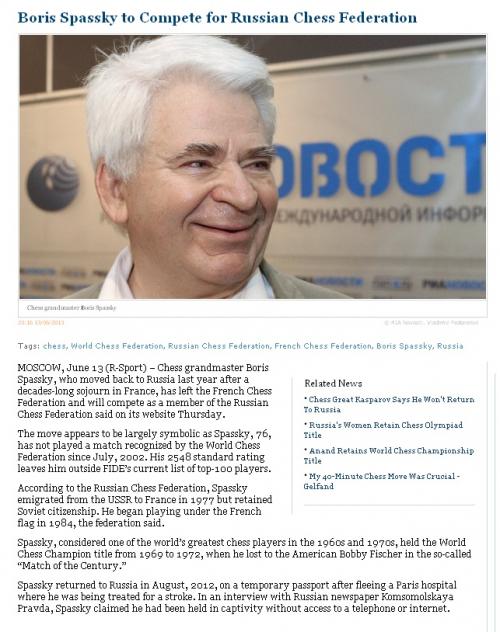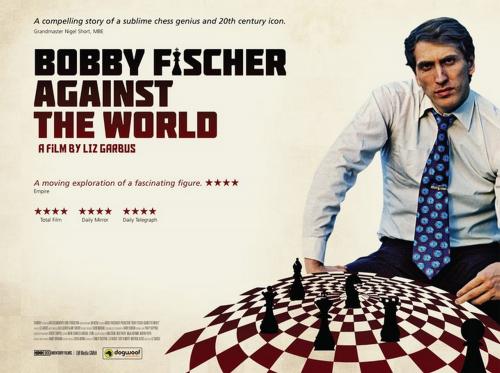-
Par 1 euro Lycée Leclerc dans Histoire et media : The chess match of the century between Bobby Fischer and Boris Spassky as seen by the media from 1972 to nowadays. le 12 Mai 2014 à 15:18
Spassky vs Fischer

The postcard shown here was designed by Halldor Petursson (1911-1976), a famous Icelandic caricature cartoonist who drew 18 cartoons of the most famous chess match in history for a local newspaper called The Reykjavik Grapevine. It is a representation of the chess match between US grandmaster Bobby FISCHER and USSR grandmaster Boris SPASSKY that took place in 1972, during the World Chess Championship. It is taken from Picasaweb.com; it’s a website where you can find photos.
We can notice that the cartoon is divided into two different parts:
On the left hand side of the cartoon, there is a man standing on a piece of chess, riding a horse. He represents the knight of a chess game. He’s wearing red and white striped pants and a blue shirt with stars, with cow-boy boots and a pistol in a belt. We can deduce that his outfit represents the American flag and he looks like a cow-boy. The man wearing this outfit is Bobby Fisher; he is a young American chess player. He’s also holding a very big bag on his shoulder ; both the “dollar” and the “pound sterling ” are printed on it. Those symbols show us the powerof money in capitalism.
If the Americans are on the left, we can deduce that the people standing on the right stand for the USSR . Boris Spassky, the world chess champion of that time is also a piece from the chess game, called the rook. It is represented in red, the colour of communism, and there is the Russian symbol (red star and hammer) on it. Boris Spassky wears a suit and has a big head, compared to Bobby Fischer. He’s holding an impressive crown in his left hand and with the other hand, he’s holding Fischer’s arm. Somehow, Fisher is trying to grab the crown of the World Chess Champion. Spassky has a big smile on his face; he is self-confident while Fischer looks disappointed. Spassky owns the crown and no one can ever have it. Furthermore, the rook is represented in such a way that we think it’s impressive. It also seems difficult to be taken. The chess match appears to be a hard game and Spassky will do all his best to keep the title.
From a wider perspective, the Fischer-Spassky match had a unique political importance. In fact this caricature shows the face to face between capitalism and communism, between the power of money and ideology, another conception of life (which is different in communism).
“Gens una sumus” means “we are one people”, is the World Chess Federation motto. It means one big family which confronts two members during a chess match, but which will be reconciled in the end.
We’ve chosen this photo because it’s a good description of what we are studying in class. It represents the confrontation between the US and the USSR, capitalism and communism. It also shows us the two different conceptions of life from the capitalistic point of view and the communist one.
 votre commentaire
votre commentaire
-
Par 1 euro Lycée Leclerc dans Histoire et media : The chess match of the century between Bobby Fischer and Boris Spassky as seen by the media from 1972 to nowadays. le 12 Mai 2014 à 15:12
Monday, 6th January 2014
FISCHER, THE “CHESS MAN”

In a few days, Spassky will celebrate his 77th birthday. Thus, it is a good opportunity to remember the chess match played by this famous Soviet player in 1972. Spassky, and more generally the USSR, was the big master of chess. But the American player named Fischer came like a bolt out of the blue.... As a result, it is interesting to wonder who Fischer really was and why this chess match was called “the chess match of the century».
How about studying a video? (Link:http://www.youtube.com/watch?v=7ZLrcafDtkg&list=TLWIv_B8o4RxzF2JRJB7X09q2ku7XkzKjf )
The document we have to study is an extract of a video of Bobby Fischer’s interview. It comes from an American youtube channel named “Colorado Springs Chess News Channel”, whose goal is to show the viewers the funny side of chess and gives tricks by means of homemade videos. As this channel shows chess through TV, movies or music, it can be inferred that this interview was released on TV first. No specific information about the source can be found. Even though the reliability can be questioned, we can see “the real” Fischer answering questions asked by an interviewer. Thus, we can trust it. This interview was broadcasted in 1972, after Fischer,the American, became the 11th World Chess grandmaster against the Soviet Spassky. This chess match was played during the Cold War, which was characterized by an alternation between improvements and tensions between the USA and the USSR. For example, the treaty SALT 1, which limited the arm race, was signed in 1972. In the same period, this simple game was considered as a state issue. The interview deals with Bobby Fischer’s motivations, his projects for his future, his next target, and finally it talks about his expectations regarding a return match against Spassky and the next matches more generally. This document allows the audience to know Fischer’s personality. Indeed, he seems self-assured and insinuates that he is the best player. Nevertheless, his behaviour highlights the fact that he doesn’t feel at ease with the media. Actually he doesn’t look into his interviewer’s eyes and doesn’t stay still on his chair. Last but not least, his interview shows us his unreliable side.
We chose this document because it helps us to figure out the American player’s behaviour. It is actually very important for the progress of the match. Thanks to his requests and his behaviour, Fischer succeeded in influencing his opponent. After all, he didn’t win only because of his talent. In addition, his unreliable attitude, shown by the video, expressed itself during the whole championship. For example, he failed to show up for more than a week and came late to the rescheduled match. Apart from the championship itself, he refused to play against another Soviet for the next title of world champion, and resurfaced 17 years for the rematch against Spassky.
On the other hand, the chess match of 1972 reflects the Cold War. More than a simple game, it was a “war without shouting”. The grandmasters knew they fought for the supremacy of their country. They were divided on everything and it highlighted the opposition between the USA and the USSR. Fischer represented the USA even better as he was deeply anti-communist. He had sometimes paranoid disorders about that, which may show he was mentally disturbed, as we can guess it in the video. Fischer is quite patriotic too, since he promotes his country, and has a capitalist way of thinking.
To conclude, it is interesting to study this document since Fischer’s personality influenced the outcome of the chess match, which is a good way to understand the American-Soviet relations during the Cold War.
A.Debus. M.Dorn. AM.Goetz. AL. Lehmann.
Sources : http://www.youtube.com/user/cschessnews?feature=watch
http://fr.wikipedia.org/wiki/Bobby_Fischer
 votre commentaire
votre commentaire
-
Par 1 euro Lycée Leclerc dans Histoire et media : The chess match of the century between Bobby Fischer and Boris Spassky as seen by the media from 1972 to nowadays. le 12 Mai 2014 à 15:08
Boris Spassky, the third half-time
by Mosser Romain - Garcia Renan -Sutter Gabriel - Premieres Euro

Boris Spassky, the famous soviet chessmaster, got an important career thanks to his Chess World champion’s title he got in 1969.He was very famous , until the match he lost against Bobby Fischer in 1972; it was a turning point in his career. We will study an article which deals with the continuation of his career.This article was written by a Russian reporter: Vladimir Fedorenko from the newspaper RIAnovosti.
This newspaper is one of the most important in Russia; their watchword is “the Establishment and Tasks of the Soviet Information Bureau”. The success of Rianovosti comes especially from the Internet and the Western newspapers (they congratulate Rianovosti for its reliability). The point of view of the document may be unbiased, because of the reputation of the newspaper.
This article is taken from this newspaper’s website and was published on the 13th June 2013 in the sports’ section. It deals with the fact that Boris Spassky, after having been in the French Chess Federation, wanted to integrate the Russian one. Indeed, he became very famous thanks to his performance during the 60s and the match in 1972. This match was considered as the “Match of the century” because it opposed two Chessmasters coming from the two biggest powers at that time: The USSR and the USA. After his defeat, he went to France (where he began playing chess under the French flag in 1984).He wanted to flee from the USSR , because he was afraid of reprisals.
In august 2012, he returned to Russia .There, he claimed he had been held in captivity and he didn’t have access to a telephone or the internet.
Today, we don’t know if Mr Spassky will integrate the Russian Chess Federation or not. Perhaps his last experience, in 2012, changed his mind. It reflects the fact that the Russian Government says they are democratic and they respect the Human Rights, but ,in reality, this isn’t really true !
 votre commentaire
votre commentaire
-
Par 1 euro Lycée Leclerc dans Histoire et media : The chess match of the century between Bobby Fischer and Boris Spassky as seen by the media from 1972 to nowadays. le 12 Mai 2014 à 14:57
Bobby Fischer

The document we have here to study is a poster taken from from a documentary which explores the life of the US chess master Bobby Fischer. The documentary was made by Liz Garbus in 2011. It deals with the world chess championship in 1972 between the USSR with Boris Spassky and the US with Bobby Fischer. This documentary poster is taken from the website http://www.veroniquechemla.info/2011/08/64-cases-pour-un-genie-bobby-fischer-de.html. We can notice that the facts listed are based on a historical context ; this make us infer, we can rely on it.
On the left hand side we can see the title “Bobby Fischer against the world”; the characters are in capital, and the colours are black and dark red. We can see that the "i" in Fischer is the king pawn, so we can deduce that Bobby Fischer is considered as the major component of the game in 1972. We can notice that this documentary was really appreciated by the American press; the magazine Empire commented “A moving exploration of a fascinating figure”. They also rated this documentary " four stars" like three other newspapers. This documentary was, however, just released in the United States of America. Moreover, Nigel Short, the British Grandmaster, expressed: “A compelling story of a sublime chess genius and 20th century icon”
Then on the right hand side we can see the illustration: it shows Bobby Fischer; he seems to look determinate and confident. He's in a relaxed position as if he dominated the world. It illustrates the title "Bobby Fischer against the World"
The chess table is in front of him; it represents the world and reminds the title of the documentary that is “Bobby Fischer against the world”.
Conclusion:
Considered by many to be the world's greatest chess player ever, Bobby Fischer personified the link between genius and madness.
As a loner with no familial support, Fischer had to defend his title while representing his country against the mighty Russians during the cold war. The center of media attention, Fischer was never equipped for a life in the spotlight.
"Bobby Fischer Against the World" exposes the disturbingly high price Fischer paid to achieve his legendary success. Rare archival footage and insightful interviews with those closest to him expand this story of a mastermind's tumultuous rise.We decided to choose this document because it is interesting to see a different point of view in a different period, and also a cinematographic point of view.
Annaëlle Barbat 1ES1, Thess Tilly and Lara Ergül 1S1
 votre commentaire
votre commentaire
-
Par 1 euro Lycée Leclerc dans Histoire et media : The chess match of the century between Bobby Fischer and Boris Spassky as seen by the media from 1972 to nowadays. le 12 Mai 2014 à 14:46
‘’Bobby Fischer Against the World’’
The document is a painting entitled “Bobby Fischer against the World”. It was draw by an Austrian illustrator named Oliver Schopf born in Kitzbuehel, Austria, in 1960.
Bobby Fischer was an American chess prodigy, grandmaster, and the eleventh World Chess Champion. He is considered by many to be the greatest chess player who ever lived. He was born in the 9th of March 1943 and died in the 17th January 2008.
It shows two different periods of Bobby’s life : the first part deals with the climax of his life, from the point of view of the world, when he won The chess match of the century, in 1972, against Boris Spassky, a Soviet chess grandmaster.
Then the second part shows how he ended up, more precisely when Bobby Fischer returns to Iceland, where he had celebrated his greatest victory, as a new citizen of Iceland.
It was painted before 2008, before Bobby’s death, and after the chess match that is painted here so after 1972 and logically after he became a Citizen of Iceland on March the 22nd of 2005. So it was painted between 2005 and 2008.
It’s taken from Oliver Schopf’s official website, which is for sure trustworthy:
http://www.oliverschopf.com/ . We can find on this website the work done by this artist and some information about his life.
We have chosen this document because it shows the choice that Bobby has made and in our opinion, this is the most interesting and important thing about his life : he decided to go to Iceland to be alone and stopped playing the chess tournaments.
It’s a little “bad” because he was a very good chess player, that’s why Oliver Schopf represented him when he was “old”, to show how he has broken such a wonderful destinity he could have if he had continued to play.
Bobby has made a “hole” in his life as shown in the painting : he completely changed, if he was still alive he probably wouldn’t go back to his old life to complete it and die as a hero, he just ended up looking like a homeless bum.
To finish, Oliver Schopf has chosen the title “Bobby Fischer Against the World” to show Bobby’s special personality. Indeed Bobby was a little strange because he liked to be alone and “against the world”. He was paranoiac because for example ,he changed different things ( lights ..) during the Chess Match against Boris .
 votre commentaire
votre commentaire Suivre le flux RSS des articles
Suivre le flux RSS des articles Suivre le flux RSS des commentaires
Suivre le flux RSS des commentaires




